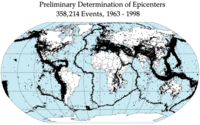
Photo from wikipedia
Earthquake epicenter distributions do not provide any information on the fault strike alone. To determine the correct fault strike considering the epicenter sequences in these distributions, it is necessary to… Click to show full abstract
Earthquake epicenter distributions do not provide any information on the fault strike alone. To determine the correct fault strike considering the epicenter sequences in these distributions, it is necessary to know both the fault mechanism and the focal depths. The mechanism is of crucial importance with the character of the fault zone in question. However, the depth information is a more efficient parameter for such a purpose. Therefore, one of the procedures that must be carried out for a region with known earthquake parameters is the extraction of the depth section. The earthquake hypocentral section is an important subject of Earth sciences and it is very crucial in active tectonics. Unfortunately, these sections have not been extracted very accurately in the studies so far worldwide. The easy and fast extraction of these cross sections, which are produced from the parameters of epicentral distance and focal depth, is possible through carrying out of the extraction of cross sections by means of a computer. The data sizes used today make this indispensable. HYPOSEC is a Fortran 95 computer code produced for this purpose. The design, running principles, and product of this software program are the subject of this study. HYPOSEC is a robust Fortran code list with a size of 345 KB that uses 16 subprograms composed of 2000 lines. Its version in this study is limited to producing the desired cross-section data. Drawing is not included in this version. The preference for drawing belongs to the user. HYPOSEC is based on an interactive and easy-to-use algorithm. It may use not only a data file compatible with the program’s format (TUREQ3.DAT) but also special data files according to the preference by the user. Besides the extraction of a simple hypocentral depth section, HYPOSEC also allows monitoring the rupture process concerning an earthquake. This operation can be performed according to time or space in parallel with user’s preference. In this study, the HYPOSEC software program is used for both the October 23, 2011 (Mw = 7.1) Tabanlı-Van earthquake and the May 24, 2014 (Mw = 6.9) Saros (Northern Aegean Sea) earthquake. For the Van earthquake, it was applied to the aftershocks that occurred within the first 3 months, 6 months, 9 months, 1 year, 1.5 years, and 2 years after the main shock. These data in use belong to the electronic earthquake catalog by Kandilli Observatory and Earthquake Research Institute of Boğaziçi University. A total of 7766 earthquake data were used during these applications. The cross sections of the different strikes selected according to the faulting strike of the earthquake concerned, its rupture surface, and its relationship with the regional tectonism are extracted by means of HYPOSEC and studied comparatively. Accordingly, a seismogenic zone that subducted northward with a slope of about 25° was activated with the process of the Van earthquake. As also for the Saros earthquake, its consecutive cross section defined the fracture mechanism was made. According to this successive cross section, it was seen that progressing of the fracture mechanism after the main shock had performed as more heavy in the footwall.
Journal Title: Arabian Journal of Geosciences
Year Published: 2019
Link to full text (if available)
Share on Social Media: Sign Up to like & get
recommendations!